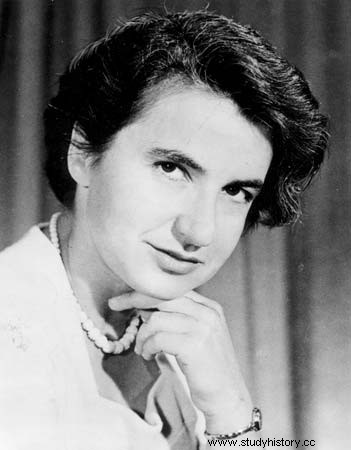Rosalind Elsie Franklin (1920 – 1958) was a British molecular biologist who helped discover the structure of deoxyribonucleic acid (DNA).
Chemistry studies
 Daughter of Muriel Frances Waley and Arthur Ellis Franklin, Rosalind was born on July 25, 1920 in Notting Hill (London ) in a very influential family. She is the second child in a family of five. From her early childhood, Rosalind showed great predispositions for school and studies. At St Paul's Girls' School in London, she excelled in science, Latin and sport.
Daughter of Muriel Frances Waley and Arthur Ellis Franklin, Rosalind was born on July 25, 1920 in Notting Hill (London ) in a very influential family. She is the second child in a family of five. From her early childhood, Rosalind showed great predispositions for school and studies. At St Paul's Girls' School in London, she excelled in science, Latin and sport.
In 1938, Rosalind left to study chemistry at Cambridge and graduated in 1941 before passing her thesis in physical chemistry in 1945; there she worked on the properties of coal. At the end of the Second World War, she moved to France to work until 1950 at the Central Laboratory of State Chemical Services. There she learned the techniques of X-ray diffractometry.
The structure of DNA and RNA
In 1951, Rosalind Elsie Franklin returned to London and obtained a position at King's College London, in a unit headed by John Randall, where she applied what she had learned in France to the study of biological materials. She was initially supposed to work on proteins and lipids but John Randall redirected her work to deoxyribonucleic acid (DNA). Along with a student, Raymond Gosling, Rosalind takes several DNA x-rays. Maurice Wilkins and she are working, each on their own, on the structure of DNA. Two years later, when she wanted to leave King's College because of a bad working atmosphere, her photographs were entrusted to Maurice Wilkins and shown to James Dewey Watson.
In 1953, Rosalind finally left King's College for Birkbeck College, where she used the technique of crystallography on viruses. She works on the tobacco mosaic virus (TMV) as well as on the structure of ribonucleic acid (RNA). The same year, James Dewey Watson and Francis Crick published in the journal Nature their discovery of the double helix structure of DNA, for which Rosalind's photographs were instrumental; only a footnote mentions his work.
The lack of recognition
In 1956, Rosalind Elsie Franklin began to suspect that she had a health problem. In September, she was operated on for two tumors in her abdomen. During her recovery, she continues to work and produce results. In 1957, she fell ill again and had to be hospitalized. On April 16, 1958, Rosalind Elsie Franklin died of ovarian cancer, perhaps contributed to by long exposure to radiation.
In 1962, the discovery of the structure of DNA earned Watson, Crick and Wilkins the Nobel Prize in Physiology or Medicine. Unable to obtain the Nobel Prize posthumously, Rosalind is not one of the laureates; she will not be mentioned in Crick and Watson's speeches.
